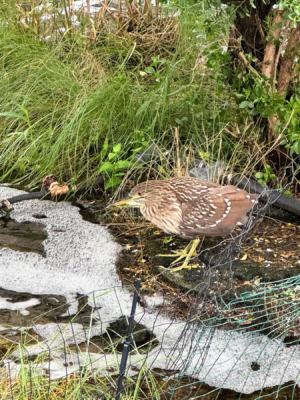A rare colony of night herons nest near the Baltimore waterfront
These resilient herons find a home in waterfront cities

Back when I lived in Baltimore, I made frequent use of the waterfront promenade between Canton and Fells Point. This was where I walked my dog, went for runs and strolled around after dinner, admiring the idyllic sunset over the busy harbor.
After a while, I started noticing this stocky bird sitting by the edge of the promenade in the evening, staring into the water. After taking pictures, I learned that this was a black-crowned night heron, one of a few herons that are native to the Chesapeake Bay region. Like all herons, they are drawn to marshes and wetlands where they can safely fish and raise their young, similar to what once lined the Baltimore harbor. They nest in trees alongside other night herons, with up to a dozen nests in one tree.
What sets black-crowned night herons apart is their diet. While other herons eat mostly fish, black-crowned night herons supplement their diets with rats, snakes and even the chicks of other herons. They feed at night, likely to limit competition from other herons (even when there aren’t any around).
After doing a bit of research, I found out that the black-crowned night herons I was seeing came from a colony nesting in the trees of Thames Street Park in Fells Point. Mind you, this is a small pocket park in a busy part of the city, where locals and tourists patron bars from happy hour to close, and loud street cleaners stroll through in the morning. But despite that, a colony of night herons seemed to have taken up shop in what few trees lined the park. As of last summer, about 60 herons were nesting in eight trees of Thames Street Park, according to the Instagram fan account, T.S. Night Heron.

As year-round residents of the Chesapeake, black-crowned night herons start breeding as early as February, with new adult birds joining the colony as late as April. Females lay 3–5 eggs from mid-March to late April with most eggs hatching between late April and late May. After about six weeks, the young start to fledge, which is when they lose their baby feathers and become capable of flight.
At this point, it's common for chicks practicing their flying around Thames Street Park to injure themselves on the asphalt, instead of the soft marsh grass their biology preps them for. Baltimorians, ever a compassionate lot, frequently find these injured birds and take them to the Phoenix Wildlife Center roughly 25 miles north. After treatment, the young birds are sometimes brought back to the Thames Street colony.
As I look back, it’s amazing to think this more or less thriving colony was living amongst the trees that I walked past most weekends, on my way to the farmer’s market. According to Baltimore’s local National Public Radio station, WYPR, black-crowned night herons nesting in cities has been on the rise over the past decade, with populations in other cities like Richmond, New Orleans and Los Angeles.
It’s inspiring to see a unique Chesapeake bird find a home in waterfront destinations like Baltimore, even if the city has a lot of work to do to make its waters swimmable and fishable year-round. As things improve, perhaps the local night heron population will expand, and other Chesapeake Bay birds will join them. If you’ve seen night herons in a city near you, or any other unexpected visitor, let us know in the comments.

Comments
There is a family of night herons in Harborview! A few weeks ago we saw an adult night heron fishing at dusk, and this afternoon we saw a juvenile fishing in the same spot. I wonder if the juveniles are more active during the day.
In Chicago, there's been an increasing large colony in LIncoln Park Zoo these past ten plus years. Displaced from historic wetland nesting sites some 20 miles south east, the colony at the Zoo has now grown to number hundreds. Their populations in Illinois, the Great Lakes and Northeast are declining. There's a project underway studying them and working to build new conservation strategies, both for urban adaptation/co-existence, and potential restoration to exurban nesting sites. Find a link tree to articles and conservation partners' websites via Instagram page @chibcnhproject. We're very interested in urban rookeries elsewhere, and recently visited the Detroit Zoo, which has also had BCNH nesting there, not as many as in Chicago, since 2002.
Thank you!
Your comment has been received. Before it can be published, the comment will be reviewed by our team to ensure it adheres with our rules of engagement.
Back to recent stories